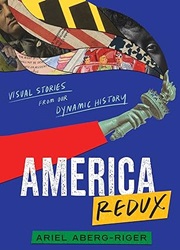
 America Redux
America ReduxVisual Stories from Our Dynamic History
Review posted January 19, 2024.
Balzer + Bray, 2023. 294 pages.
Review written July 4, 2023, from a book sent to me by the publisher.
Starred Review
2024 YALSA Excellence in Nonfiction Award Finalist
2023 Kirkus Prize for Young Reader's Literature Winner
2023 Sonderbooks Stand-out:
#7 Teen Nonfiction
Finishing this book on July 4th was wonderfully appropriate, though because it’s eligible for the Morris Award, I can’t talk about it yet, which is frustrating.
America Redux is a book of visual American history for teens. What do I mean by visual history? The author and artist took mostly public domain images from the time periods of the stories she discusses and made collages. Then she hand-lettered the story on the collages.
The history here isn’t told in consecutive order. The author takes twenty-one issues that still affect us in America today and gives the history of that issue. Some go back farther than others. Some don’t have obvious implications today (though most do), but are fascinating stories.
The book is a quick read, a delight to the eyes, and incredibly interesting. I wished almost every chapter was longer – but the author has a list of resources in the back, sources of quotations, and where you can look to explore the topic more. So she gives enough to completely suck you in. Also enough to give you conversation at parties! Just last Sunday, I began talking about urban SROs – Single-Room Occupancy dwellings – how common they once were and how cities cracking down on them in the 1970s drove up the price of housing. I learned about it in this book.
This book is hard to resist. Its bright colorful images pull your eyes to the page. This is not a textbook or a replacement for a textbook, but it focuses on history you won’t necessarily learn about in school – things like freeways getting built through land owned by minorities, Sam Colt and his genius marketing abilities (paid product placement with his guns in paintings!), the history of squelching immigration, propaganda and the American Revolution, Mustafa Al-Azemmouri – a Black Muslim explorer of the Americas, the Eugenics movement and forced sterilization, Love Canal and the pollution still all around Niagara Falls – and so much more.
If the topics sound random, they felt a little random, not necessarily related to one another or in any particular order. But each one was so fascinating, I completely forgave the author for that. I came away from this book knowing much more about American history and with my curiosity piqued to find out yet more.
